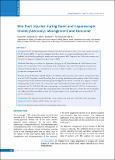Please use this identifier to cite or link to this item:
https://hdl.handle.net/20.500.14356/1855| Title: | Bile Duct Injuries during Open and Laparoscopic Cholecystectomy: Management and Outcome |
| Authors: | Sapkota, S Pathania, O P Sah, P L Gupta, R K Agrawal, C S Sah, S |
| Citation: | Gupta RK, Agrawal CS, Sah S,S. S. P. O. S. P. (2013). Bile Duct Injuries during Open and Laparoscopic Cholecystectomy: Management and Outcome. Journal of Nepal Health Research Council. https://doi.org/10.33314/jnhrc.v0i0.389 |
| Issue Date: | 2013 |
| Publisher: | Nepal Health Research Council |
| Article Type: | Original Article |
| Series/Report no.: | May-Aug, 2013;389 |
| Abstract: | Abstract Background: The widespread application of laparosopic cholecystectomy has led to a rise in the numbers of major bile duct injuries (BDI). Perioperative management of these injuries is complex and challenging. There are few published reports locally regarding the perioperative management of BDI. Purpose of this review was to analyze our experience in diagnosis, management and prevention of BDI. Methods: This study was conducted in department of surgery at B. P. Koirala Institute of Health Sciences. From January 2001 to September 2010, a observational study of all patients with a BDI following cholecystectomy was maintained. Patients’ charts were retrospectively reviewed to analyze incidence, type of injury, presentation, and perioperative management of BDI. Results: A total of 92 patients had BDI which occurred during cholecystectomy, were analysed retrospectively. There were 60/92 (65.5%) patients with BDI resulting from the wrong identification of the anatomy of the Calot’s triangle during cholecystectomy. Abdominal ultrasonography was diagnostic for BDI in 71/90 (78.8%). Magnetic resonance cholangiography could reveal the site of injury, the length of injured bile duct and variation of bile duct tree with a diagnostic rate 22/23 (95.6%). The most common injury was Strasberg’s E2 in 65/92 (70.7%). A transection or stricture of the bile duct was repaired by hepaticojejunostomy (83 cases in this series). Seventy-five (81.5%) patients were followed up. The mean follow-up time was 2.6 years (range 0.16-6). Good results were achieved in 62/75 (82.6%) of the patients. Conclusions: The high success rate of bile duct repair in the present study can be attributed to the appropriate timing, meticulous technique and the tertiary care experience. |
| Description: | Original Article |
| URI: | http://103.69.126.140:8080/handle/20.500.14356/1855 |
| ISSN: | Print ISSN: 1727-5482; Online ISSN: 1999-6217 |
| Appears in Collections: | Vol. 11 No. 2 Issue 24 May - Aug, 2013 |
Files in This Item:
| File | Description | Size | Format | |
|---|---|---|---|---|
| 389-Article Text-436-1-10-20131127.pdf | Fulltext Download | 888.72 kB | Adobe PDF |  View/Open |
Items in DSpace are protected by copyright, with all rights reserved, unless otherwise indicated.
